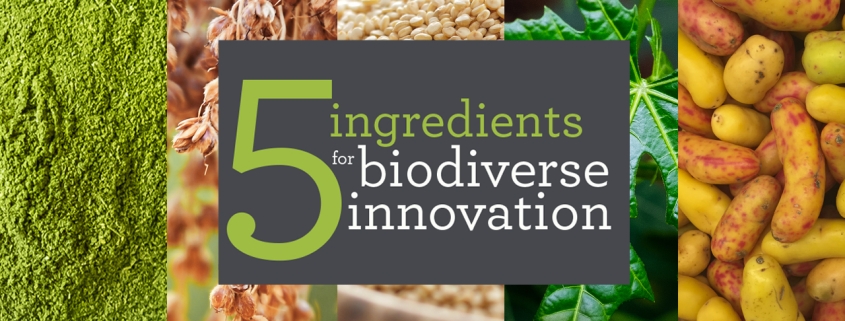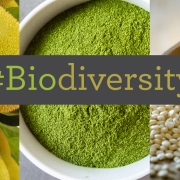5 Biodiverse Ingredients to Inspire Your Next Innovation
Biodiversity is integral to all living things on planet Earth—from the air we breathe to the foods we eat. Healthy, wide-ranging biodiversity boosts ecosystem productivity, while a loss of biodiversity—that is, the reduction or loss of a plant or animal species—creates unstable ecosystems that adversely affect our food chain (perhaps irreversibly).
Foods and ingredients that promote biodiversity draw upon a wider range of sources, thereby putting less pressure on a single species. Creating biodiverse products is beneficial to the environment and diversifies personal diets for better overall body health—which is why progressive companies are tapping into these ingredients.
With that in mind, here are 5 biodiverse ingredients to consider incorporating into your next new product innovation.
1. Moringa: This fast-growing, drought-resistant tree native to South Asia has leaves that taste like a slightly sweeter version of matcha. Moringa has a nutritional profile that rivals milk, yogurt and eggs and is packed with protein, calcium, antioxidants and other essential vitamins, minerals and nutrients. Known as a “super food,” it has been shown to support the body’s ability to lower cholesterol and blood sugar and even reduce inflammation. These qualities make it an ideal ingredient for boosting the nutritional profile of a range of foods and beverages.
2. Finger Millet: This self-pollinating, relatively fast-growing cereal plant is typically grown in Africa and Asia. Finger Millet is loaded with polyphenols, dietary fibers and calcium and it’s resistant to disease, pests and drought. Not only that, it has an extremely long shelf life. Finger Millet seeds have been safely stored for well over 10 years—and even up to 50 years—before use! With a mild corn flavor, you can be as creative as you like with this plant. Seeds can be ground and baked into whatever crave-worthy creation you dream up or used to craft refreshing beers and beverages.
3. Amaranth: This naturally gluten-free ancient grain is native to North America and can be broadly cultivated. It’s rich in Vitamin C, calcium, iron, magnesium, amino acids, phosphorus, potassium AND packed with complete proteins—making it nutritionally superior to many other grains. Amaranth touts a wide variety of benefits including an ability to aid weight loss, lower cholesterol and even reduce inflammation. From the seeds to the leaves, Amaranth is a great consideration for cereals, breakfast bars, baked goods and even beverages. The grains are also delicious when “popped” like a popcorn. With a mild, nutty flavor and an ability to readily absorb the flavors of other ingredients, Amaranth is the perfect choice for packing more nutritional power into your next product innovation.
4. Chaya: This fast-growing, leafy perennial shrub is native to Mexico and quite easy to grow. It’s pest and drought resistant and can handle large amounts of water—making it very durable and resilient. Commonly called “tree spinach,” it’s actually two to three times more nutritious than real spinach—with loads of vitamins, minerals, carotene, iron, calcium, phosphorus, protein and antioxidants. This ultra-prolific plant is used for both dietary and medicinal purposes, having been shown to improve digestion, stimulate circulation, and even counteract the effects of diabetes, obesity and acne. The leaves can be used whole or turned into a super-nutritious powder. With a mild, slightly sweet taste, chaya can be used in a wide variety of products, including juices, soups, teas and even a crave-worthy snacks like chips.
5. Ulluco: This beautiful, ultra-colorful tuber crop is native to the Andes and tastes like beet, but is similar in form to a small potato (they only grow to one or two inches in diameter). Ulluco has a super long shelf life and thrives in cool weather and poor soil conditions. It’s is a good source of fiber and has roughly 20% less calories per serving than a potato. The plant is loaded with vitamin C, calcium, protein, and high levels of antioxidants, which can be visually tracked by the vibrant pigments in the crop. If you’re looking to dance color and nutrition into your next innovation, ulluco would be a great addition.
We hope you enjoyed learning about these ingredients that are sure to make your next new product taste great while promoting a more biodiverse planet. What other ingredients that are top-of-mind when you think about biodiversity? How big of a role do you think biodiversity will have in your future innovation efforts? Feel free to email me or reach out on LinkedIn—I’d love to continue the conversation.
If you’re looking to learn more about biodiversity, be sure to check out our article inspired by our visit to the Fancy Food Show.
Jeff Johns is SVP, Creative at Seed Strategy where he consistently delivers breakthrough creative at lightning speed across a wide range of best-in-class design practices: packaging, branding, shelf-aisle optimization and advertising.
Sean Smyth is EVP, Strategy at Seed Strategy where he guides clients through the ambiguities of innovation by grounding the experience in solid principles that build certainty and confidence—often by defying established conventions.
Edited by Adam Siegel. In addition to being the Editor of The Accelerator, Adam is a Creative Director at Seed Strategy where he draws upon his diverse experience in advertising, research and innovation to craft breakthrough creative and winning concept copy.
Connect with us! Follow Seed Strategy on our LinkedIn, Twitter, Facebook and Instagram pages.






Trackbacks & Pingbacks
[…] for additional inspiration? Check out our article about 5 biodiverse ingredients to consider for your next […]
Comments are closed.